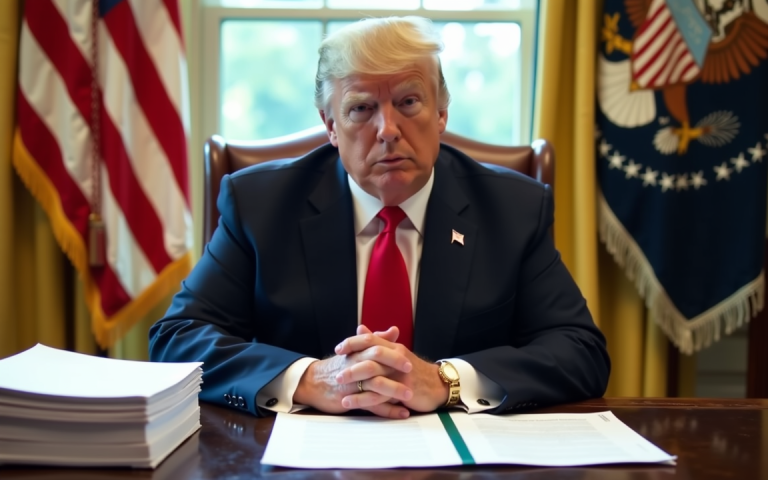After months of intensive, often grueling, negotiations and shuttle diplomacy, the fate of a critical trade agreement between the European Union and the United States now rests squarely in the hands of one man: President Donald Trump.
The high-stakes endgame is set to unfold in Scotland, where European Commission President Ursula von der Leyen will meet with the US president on Sunday in a last-ditch effort to seal a deal.
A race against the clock to avert a tariff storm
The two sides are in a desperate race against the clock. If no agreement is reached, a punishing 30% tariff on the bloc’s exports to the US is scheduled to automatically kick in on Friday.
“Intensive negotiations at technical and political have been ongoing,” said Paula Pinho, von der Leyen’s spokesperson.
Leaders will now take stock and consider the scope for a balanced outcome that provides stability and predictability for businesses and consumers on both sides of the Atlantic.
EU officials have repeatedly cautioned that, despite the detailed work of their negotiators, a final deal ultimately hinges on President Trump’s personal approval, making the outcome notoriously difficult to predict.
The US president’s recent negotiations with Japan serve as a cautionary tale; he appeared to change certain final terms on the fly just before a deal was eventually agreed upon earlier this week.
The anatomy of a potential deal: 15% tariffs and key exemptions
Over the past week, the EU and the US. have been zeroing in on the framework of a potential agreement.
According to a previous Bloomberg report, this would likely see the EU face a baseline 15% tariff on most of its trade with the US.
However, the EU is pushing hard for limited but crucial exemptions for key sectors, including aviation, some medical devices and generic medicines, several types of spirits, and a specific set of manufacturing equipment that the US needs.
Under the arrangements being discussed, steel and aluminum imports would likely benefit from a quota system, but any imports above that threshold would face a much higher tariff of 50%.
This is on top of the universal levy President Trump has threatened, as well as the existing 25% levy on cars and auto parts and the 50% duty on steel and aluminum.
He has also threatened to target pharmaceuticals and semiconductors with new duties as early as next month and recently announced a 50% tariff on copper.
The EU is expecting the same 15% ceiling to apply to some of these sectors that could be targeted in the future, including pharmaceuticals, but this remains a key sticking point where President Trump’s final decision will be crucial, according to people familiar with the matter.
‘A 50-50 chance’: Trump’s take on the high-stakes game
President Trump himself has maintained an air of suspense about the negotiations.
“We’ll see if we make a deal,” he said as he arrived in Scotland on Friday. “Ursula will be here, highly respected woman.
So we look forward to that.” He reiterated his belief that there’s “a 50-50 chance” of a deal with the EU, stating there were still sticking points on “maybe 20 different things” that he did not want to detail publicly.
However, he also acknowledged the significance of a potential agreement, stating, “That would be actually the biggest deal of them all if we make it.” Before leaving Washington, he had given similar odds but also suggested the EU had a “pretty good chance” of reaching an agreement.
If a deal is struck, it is likely to take the form of a short joint statement, which would then need to be approved by the EU’s member states.
This statement would be seen as a crucial stepping stone toward more detailed and comprehensive talks in the future.
Any agreement would also likely cover non-tariff barriers, cooperation on economic security matters, and strategic purchases by the EU in sectors such as energy and artificial intelligence chips.
Europe’s Plan B: a powerful retaliation arsenal
Because of the ongoing uncertainty and the unpredictability of the negotiations, the EU has, in parallel, been sketching out a powerful set of countermeasures in the event of a no-deal scenario.
If talks collapse and President Trump carries through with his threat to impose the 30% tariff rate on most of the bloc’s exports after August 1, the EU is prepared to quickly retaliate. It would hit American exports with up to 30% tariffs on some €100 billion ($117 billion) worth of goods.
This list is strategically designed to hit politically sensitive US states and includes iconic products such as Boeing Co. aircraft, U.S.-made cars, and bourbon whiskey. The package also includes some export restrictions on scrap metals.
Beyond immediate tariffs, in a no-deal scenario, the bloc is also prepared to activate its anti-coercion instrument.
This is a potent trade tool that would eventually allow the EU to target other areas, such as US access to European markets, services, and restrictions on public contracts, provided a majority of member states back its use.
While President Trump did not explicitly link the trade negotiations to other matters on Friday, he did suggest that he planned to raise his concerns over migration flows in Europe.
“You got to stop this horrible invasion that’s happening to Europe, many countries in Europe,” Trump said, adding that he believed “this immigration is killing Europe.”
This adds another unpredictable element to what are already incredibly high-stakes discussions.
The post Trump gives ’50-50 chance’ for EU trade deal as leaders prepare for Sunday meeting appeared first on Invezz

